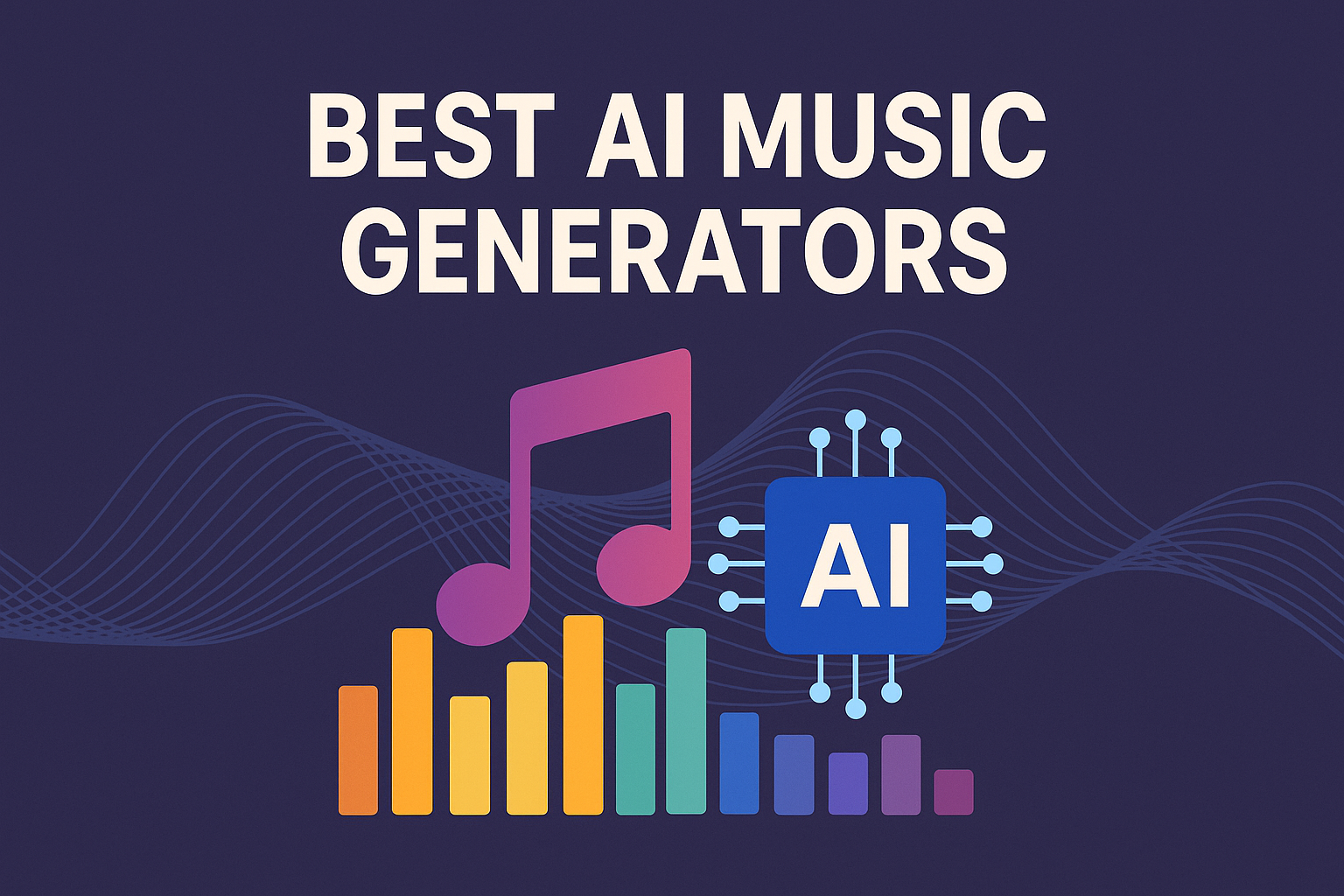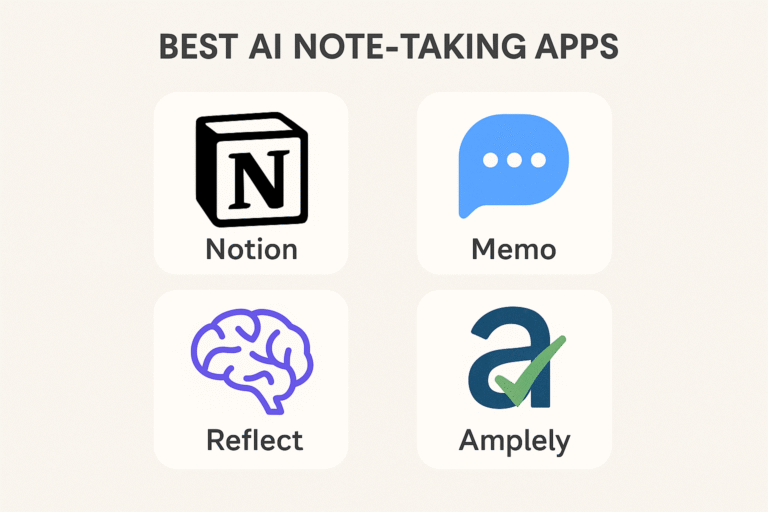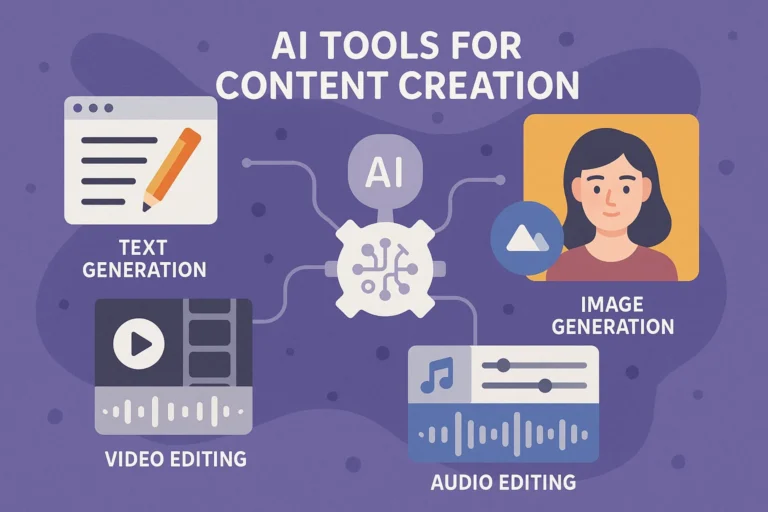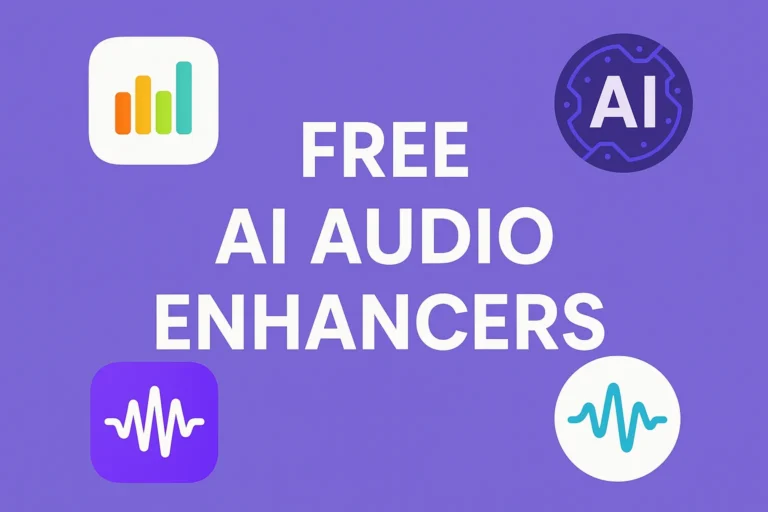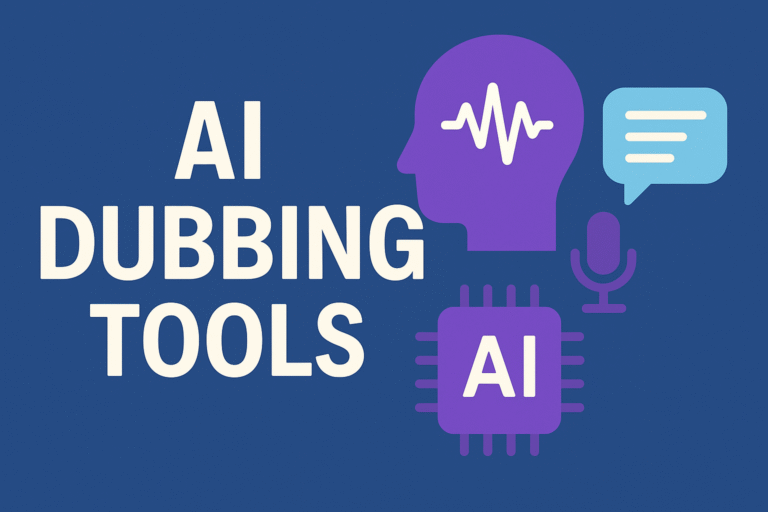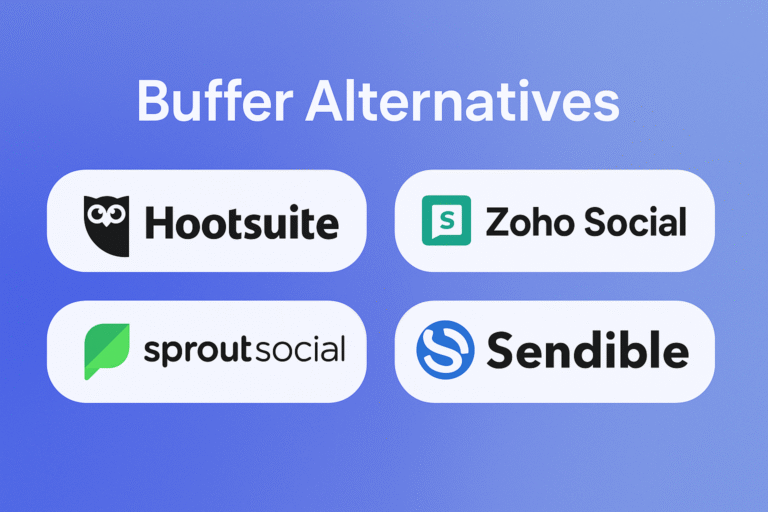Are you a content creator struggling to find the perfect background music for your videos? A musician searching for fresh inspiration to break through creative blocks? Or perhaps a business owner who needs original music for marketing campaigns but can’t afford expensive composers and licensing fees?
You’re facing the same challenge that millions of creators encounter daily. Quality music is essential for engaging content, memorable brands, and professional presentations—but traditional music creation and licensing can be expensive, time-consuming, and legally complex.
The music industry is experiencing a revolutionary transformation. AI music generators are democratizing music creation, allowing anyone to produce professional-quality soundtracks, full songs, and background music in minutes rather than months. These tools don’t just randomly generate noise—they understand musical theory, genre conventions, and emotional expression to create music that genuinely moves people.
In this comprehensive guide, I’ll walk you through the 25 best AI music generators of 2025, including 18 free options and 7 premium tools that can revolutionize your creative workflow. Whether you need a 30-second jingle or a 10-minute orchestral piece, there’s an AI tool perfectly suited to your needs and budget.
The Music Creation Revolution: Why AI Is Changing Everything
Before exploring specific tools, let’s understand why AI has become indispensable for modern music creation:
Instant Gratification: Create complete songs in minutes instead of weeks or months of traditional composition.
No Musical Training Required: Generate professional-quality music without understanding music theory or playing instruments.
Royalty-Free Content: Own the rights to your AI-generated music without complex licensing agreements.
Infinite Variations: Generate unlimited variations and iterations until you find the perfect sound.
Cost Effectiveness: Eliminate expensive studio time, musician fees, and licensing costs.
Creative Exploration: Experiment with genres and styles you’ve never worked with before.
Consistent Quality: Maintain audio quality standards across all your content.
Global Accessibility: Access any musical style or cultural influence instantly.
Understanding AI Music Generation Technology
How AI Music Generation Works
AI music generators use several sophisticated technologies:
Neural Networks: Deep learning models trained on millions of songs to understand musical patterns, structures, and relationships.
Transformer Models: Advanced AI architectures that understand context and can generate coherent musical sequences.
Generative Adversarial Networks (GANs): Two AI systems working together—one creates music, the other evaluates quality, resulting in continuous improvement.
Audio Processing: Converting between audio waveforms, MIDI data, and symbolic representations of music.
Style Transfer: Applying characteristics of one musical style to another, creating unique hybrid sounds.
Types of AI Music Generation
Text-to-Music: Generate music from written descriptions and prompts.
Style-Based Generation: Create music in specific genres, moods, or styles.
Continuation: Extend existing musical pieces or audio samples.
Arrangement: Transform simple melodies into full orchestrations.
Stem Separation: Isolate individual instruments or vocal tracks from complete songs.
Real-Time Generation: Create music that responds to live inputs or environmental factors.
Quick Comparison: Top 25 AI Music Generators
| Tool | Type | Free Tier | Best For | Max Length | Commercial Use | Starting Price |
| Suno AI | Full Songs | ✅ | Complete songs with vocals | 4 minutes | ✅ | $10/month |
| AIVA | Orchestral | ✅ | Classical and cinematic | Unlimited | ✅ | $15/month |
| Soundraw | Background Music | ✅ | YouTube, podcasts | 5 minutes | ✅ | $16.99/month |
| Boomy | Pop Music | ✅ | Simple song creation | 3 minutes | ✅ | $9.99/month |
| Amper Music | Adaptive | ✅ | Video scoring | Unlimited | ✅ | $15/month |
| Jukedeck | Background | ❌ | Corporate content | 5 minutes | ✅ | $21.99/month |
| Ecrett Music | Scene-Based | ✅ | Video scenes | 5 minutes | ✅ | $7.99/month |
| Beatoven.ai | Podcast Music | ✅ | Podcast intros | Unlimited | ✅ | $20/month |
| Mubert | Ambient | ✅ | Streaming music | Unlimited | ✅ | $14/month |
| Amadeus Code | Melody | ✅ | Melody creation | 30 seconds | ✅ | $9.99/month |
| Humtap | Collaborative | ✅ | Social music making | 2 minutes | ✅ | $4.99/month |
| OpenAI Jukebox | Experimental | ✅ | Research projects | Variable | ✅ | Free |
| Facebook MusicGen | Open Source | ✅ | Development projects | 30 seconds | ✅ | Free |
| Riffusion | Visual-Audio | ✅ | Experimental music | 30 seconds | ✅ | Free |
| Loudly | Creator-Focused | ✅ | Social media | 2 minutes | ✅ | $5.99/month |
| Splash Pro | Hip-Hop/Rap | ✅ | Rap and urban music | 2 minutes | ✅ | $8/month |
| Voicemod | Real-time | ✅ | Live streaming | Real-time | ✅ | $12/month |
| Endel | Adaptive | ✅ | Focus and relaxation | Unlimited | ✅ | $7.99/month |
| Brain.fm | Functional | ✅ | Productivity music | Unlimited | ✅ | $6.99/month |
| Flow Machines | Jazz/Pop | ❌ | Professional composition | Unlimited | ✅ | Enterprise |
| LANDR | Production | ✅ | Music production | Unlimited | ✅ | $11.99/month |
| Orb Producer | Electronic | ✅ | Electronic music | Unlimited | ✅ | $9.99/month |
| WaveAI | Mixing | ✅ | Audio enhancement | Unlimited | ✅ | $19/month |
| Tracksy | Tracks | ✅ | Background tracks | 3 minutes | ✅ | $12/month |
| Soundtrap AI | Collaborative | ✅ | Band collaboration | Unlimited | ✅ | $13.99/month |
Best Free AI Music Generators (2025)
1. Suno AI – The Complete Song Creator
Best for: Full song creation, vocal tracks, professional-quality output
Suno AI has revolutionized AI music generation by creating complete songs with vocals, lyrics, and professional production quality that rivals human-created music.
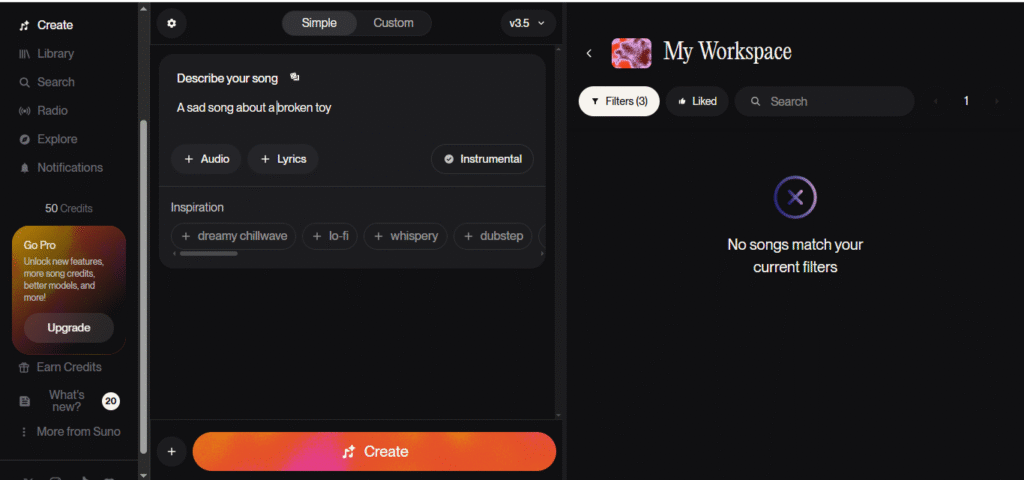
Key Features:
- Complete Song Generation: Creates full songs with vocals, instruments, and production
- Lyric Generation: AI-powered lyrics that match musical style and mood
- Multiple Genres: Pop, rock, hip-hop, classical, electronic, and experimental styles
- Professional Quality: Studio-quality output suitable for commercial use
- Customization Options: Adjust style, mood, tempo, and instrumentation
- Vocal Styles: Multiple AI singers with different tones and styles
Testing Results:
- Song Quality: Exceptional – generated songs sound professionally produced
- Vocal Realism: AI vocals are remarkably human-like and emotionally expressive
- Genre Accuracy: Successfully captures genre conventions and characteristics
- Creativity: Produces genuinely original and engaging musical compositions
Strengths:
- Best-in-class complete song generation
- Exceptional vocal quality and expressiveness
- Wide genre coverage with authentic style capture
- Professional production quality
- User-friendly interface with powerful customization
Limitations:
- Free tier has daily credit limits
- Limited control over specific musical elements
- Can’t use custom vocals or instruments
- Generated content may occasionally repeat patterns
Pricing:
- Free: 50 credits daily (10 songs per day)
- Pro: $10/month (500 songs monthly)
- Premier: $30/month (2000 songs monthly)
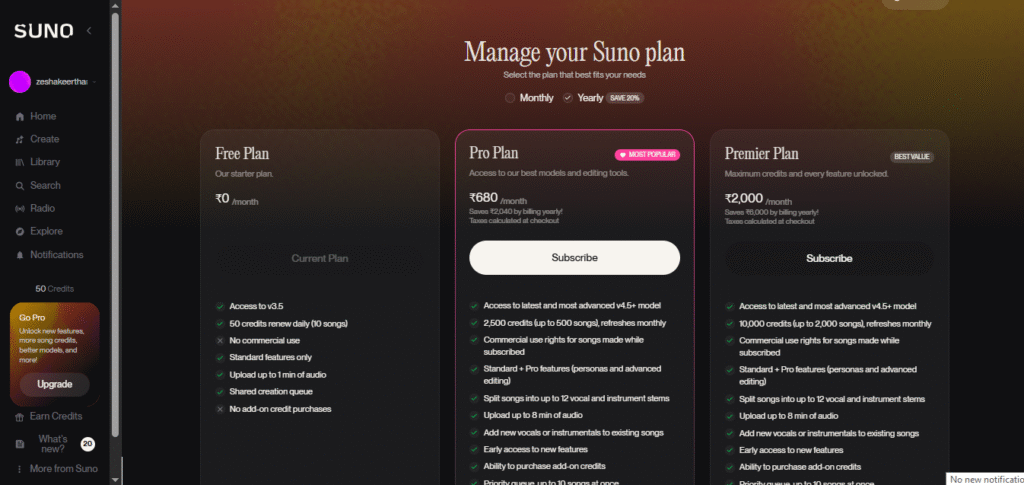
Best Use Cases:
- Content creators needing original songs for videos
- Musicians seeking inspiration and demo creation
- Businesses requiring original music for marketing
- Podcasters needing intro/outro music
2. AIVA – The Classical and Cinematic Master
Best for: Orchestral music, film scoring, classical compositions
AIVA (Artificial Intelligence Virtual Artist) specializes in creating sophisticated orchestral and cinematic music, making it perfect for professional media scoring.
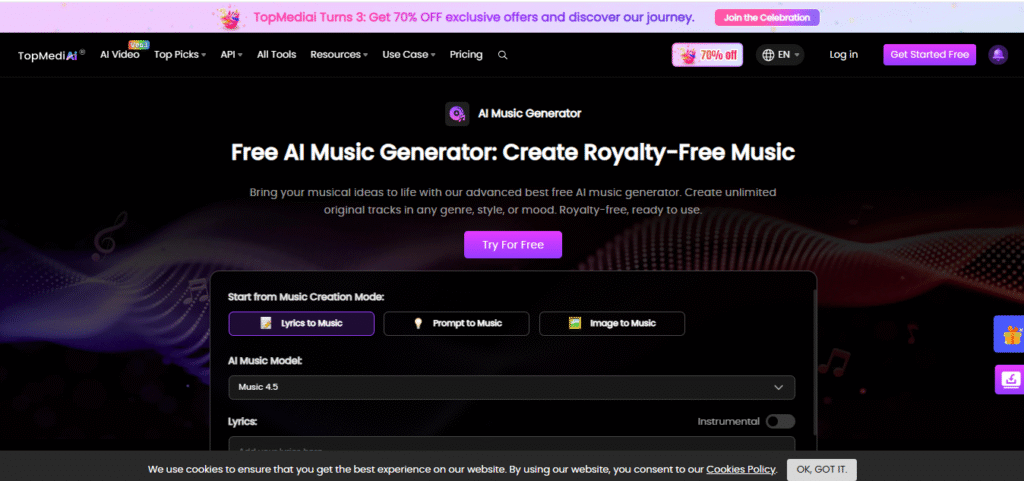
Key Features:
- Orchestral Focus: Specialized in classical, cinematic, and symphonic music
- Composition Intelligence: Understands musical theory and compositional structure
- Multiple Formats: Export as MIDI, audio, or sheet music
- Style Training: Trained on works of classical masters and film composers
- Professional Scoring: Create full orchestral arrangements
- Emotional Intelligence: Generate music that evokes specific emotions and moods
Testing Results:
- Orchestral Quality: Outstanding for classical and cinematic compositions
- Musical Sophistication: Demonstrates understanding of advanced musical concepts
- Emotional Impact: Successfully creates music that evokes intended emotions
- Professional Application: Suitable for professional film and media scoring
Strengths:
- Exceptional orchestral and cinematic music quality
- Deep understanding of musical theory and composition
- Professional-grade output suitable for media scoring
- Multiple export formats for different workflows
- Strong emotional and thematic coherence
Limitations:
- Limited to classical and orchestral styles
- Steep learning curve for advanced features
- Requires musical knowledge for optimal use
- Higher pricing for commercial licensing
Pricing:
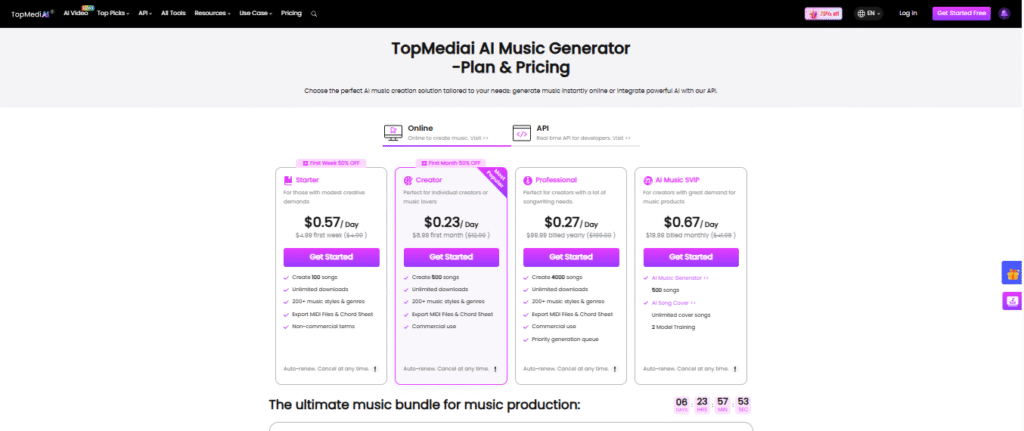
- Free: 3 downloads monthly, personal use only
- Standard: $15/month (15 downloads, commercial license)
- Pro: $49/month (300 downloads, full commercial rights)
3. Soundraw – The Background Music Specialist
Best for: YouTube videos, podcasts, background music, content creation
Soundraw excels at creating customizable background music with an intuitive interface that makes music creation accessible to everyone.
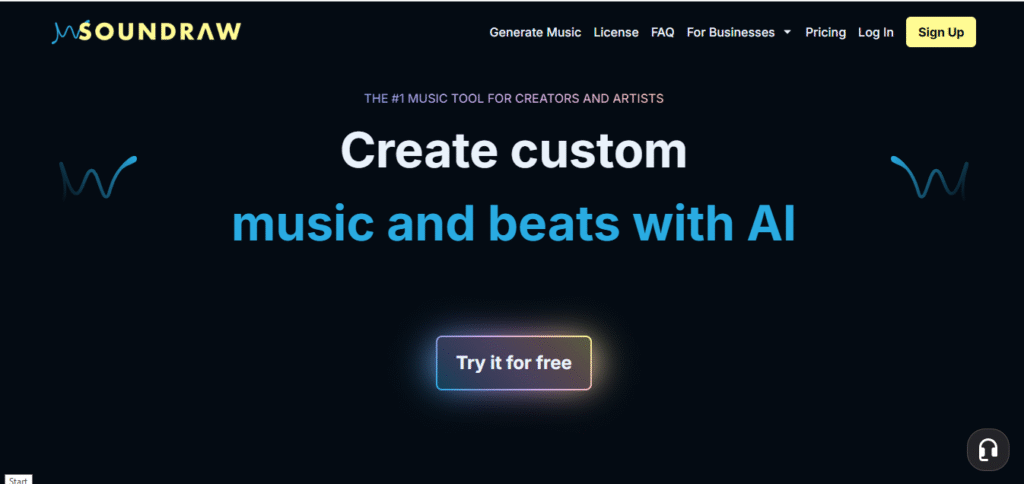
Key Features:
- Intuitive Customization: Adjust mood, genre, instruments, and energy levels
- Real-Time Editing: Modify music elements while listening to changes
- Content Creator Focus: Templates optimized for videos, podcasts, and presentations
- Unlimited Generation: Create unlimited tracks with free account
- Royalty-Free Guarantee: Use generated music without licensing concerns
- Export Options: Multiple audio formats and quality levels
Testing Results:
- User Experience: Most intuitive interface for music customization
- Background Music Quality: Excellent for video and podcast applications
- Customization Flexibility: Superior control over musical elements
- Generation Speed: Fast creation and modification of tracks
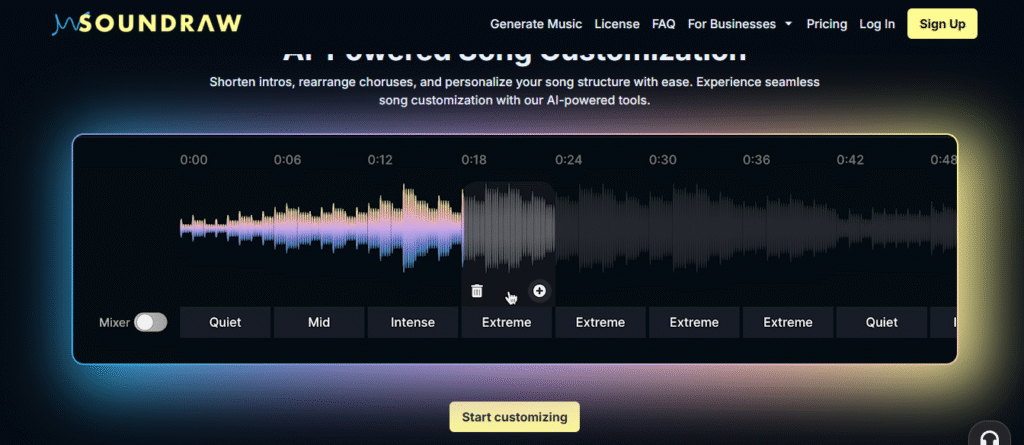
Strengths:
- Extremely user-friendly interface
- Excellent customization capabilities
- Unlimited generation on free tier
- Perfect for content creators
- Royalty-free usage rights
Limitations:
- Downloads require paid subscription
- Limited vocal track options
- Focused primarily on background music
- May feel formulaic for complex compositions
Pricing:
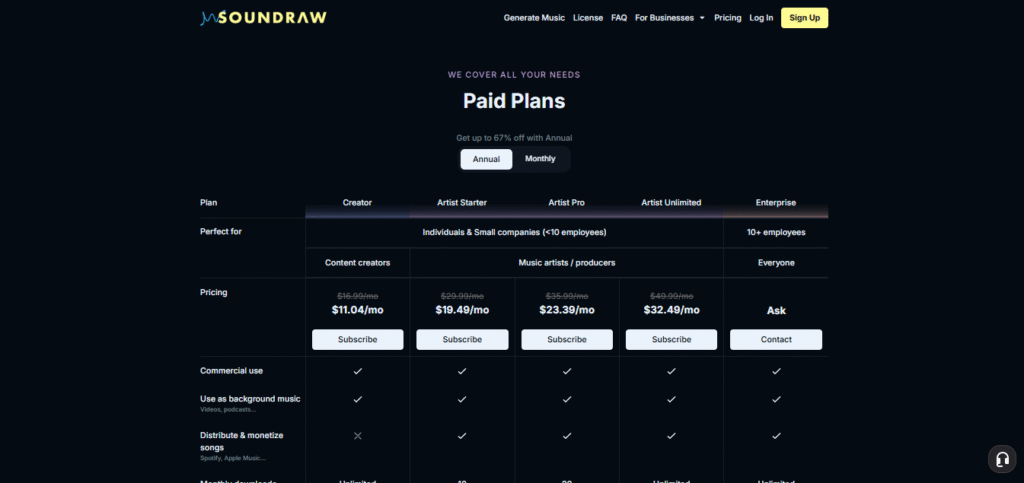
- Free: Unlimited generation, no downloads
- Creator: $16.99/month (unlimited downloads)
- Artist: $29.99/month (stems, commercial license)
4. Boomy – The Social Music Platform
Best for: Beginners, social sharing, quick song creation
Boomy combines AI music generation with social features, making it perfect for casual users and those wanting to share their creations.
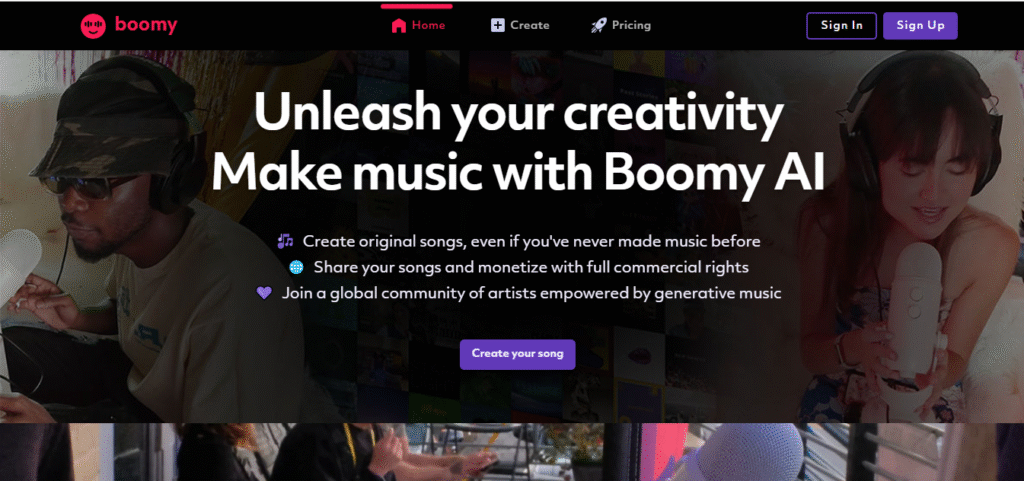
Key Features:
- Instant Song Creation: Generate complete songs with minimal input
- Social Platform: Share and discover music from other users
- Monetization Options: Earn royalties from your AI-generated music
- Simple Interface: Beginner-friendly with minimal learning curve
- Multiple Styles: Pop, rap, electronic, lo-fi, and meditation music
- Community Features: Like, share, and collaborate with other creators
Testing Results:
- Ease of Use: Exceptional for beginners with no music experience
- Social Features: Active community with engaging discovery features
- Song Quality: Good for casual listening and social media content
- Monetization: Interesting revenue-sharing model for creators
Strengths:
- Perfect for absolute beginners
- Strong social and community features
- Monetization opportunities
- Quick song generation
- No musical knowledge required
Limitations:
- Limited advanced customization
- Song quality varies significantly
- Limited professional applications
- Dependency on platform for monetization
Pricing:
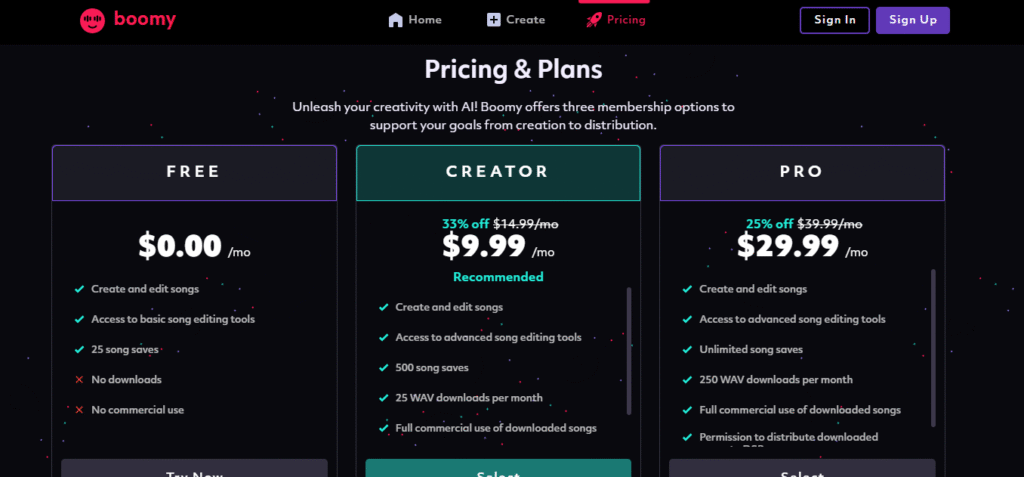
- Free: Basic song creation and sharing
- Creator: $9.99/month (enhanced features, better monetization)
5. Facebook MusicGen – The Open Source Pioneer
Best for: Developers, researchers, experimental projects
MusicGen, developed by Meta, represents cutting-edge open-source AI music generation technology available to everyone.
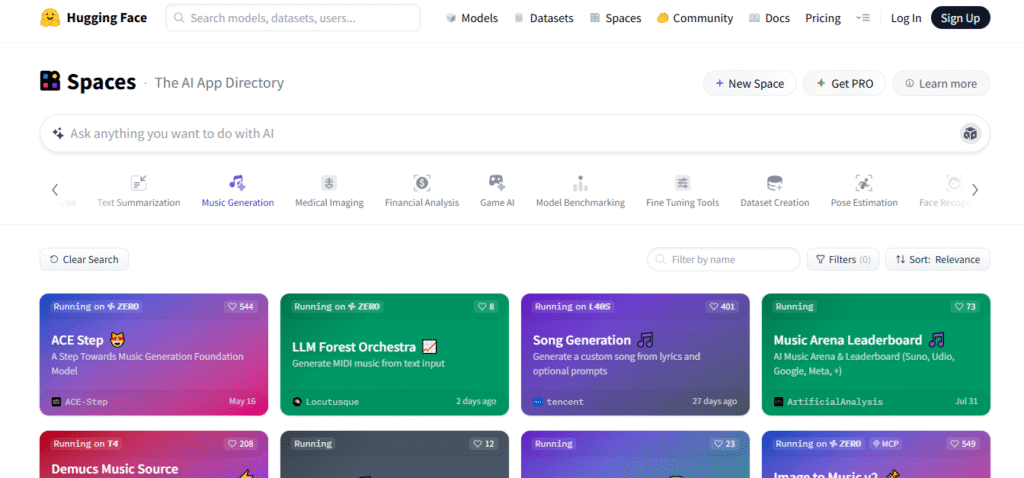
Key Features:
- Open Source: Complete access to source code and models
- Research Grade: State-of-the-art AI music generation technology
- Conditional Generation: Create music based on text descriptions and audio samples
- Multiple Models: Different models optimized for various musical styles
- Developer Friendly: API access and integration capabilities
- No Usage Limits: Generate unlimited music with proper setup
Testing Results:
- Technical Sophistication: Most advanced AI music technology tested
- Research Applications: Excellent for academic and experimental projects
- Customization Potential: Unlimited customization for technical users
- Innovation: Cutting-edge features not available in commercial tools
Strengths:
- Completely free and open source
- State-of-the-art AI technology
- Unlimited usage and customization
- Perfect for research and development
- No licensing restrictions
Limitations:
- Requires technical knowledge to implement
- No user-friendly interface
- Limited customer support
- Setup complexity for non-developers
Pricing:
- Completely Free: Open source with unlimited usage
6. Riffusion – The Visual Music Creator
Best for: Experimental music, visual artists, unique soundscapes
Riffusion uses a unique approach, generating music by creating and interpreting visual spectrograms, resulting in innovative and experimental sounds.
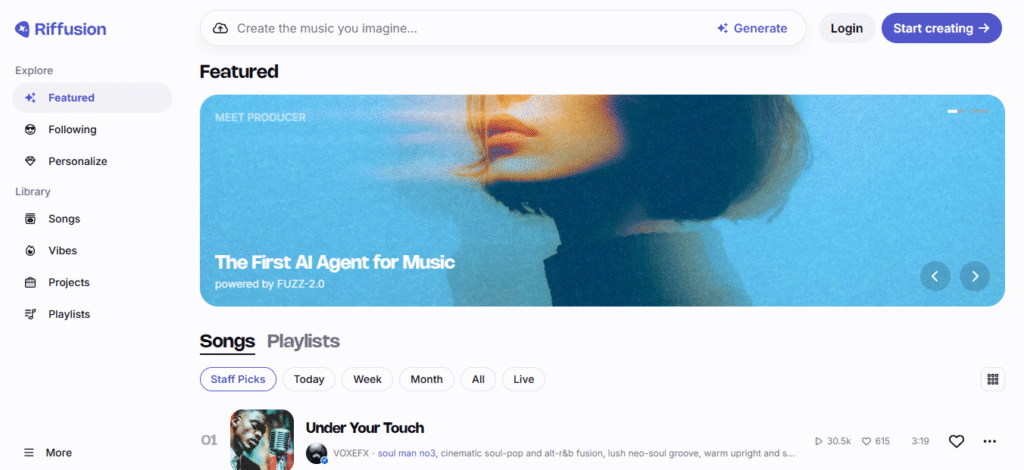
Key Features:
- Visual-Audio Interface: Create music by manipulating visual representations
- Experimental Sounds: Generate unique, avant-garde musical pieces
- Real-Time Generation: Interactive music creation with immediate feedback
- Style Interpolation: Blend different musical styles smoothly
- Artistic Integration: Perfect for multimedia art projects
- Open Source: Transparent, community-driven development
Testing Results:
- Innovation: Most experimental and creative approach to AI music
- Unique Outputs: Generates sounds and styles not found in other tools
- Artist Appeal: Excellent for experimental and avant-garde projects
- Creative Inspiration: Sparks new ideas through unexpected combinations
Strengths:
- Unique, innovative approach to music generation
- Perfect for experimental and artistic projects
- Open source and freely available
- Real-time interactive creation
- Generates truly unique soundscapes
Limitations:
- Limited commercial music applications
- Steep learning curve for traditional musicians
- Inconsistent quality for conventional genres
- Requires experimentation to achieve desired results
Pricing:
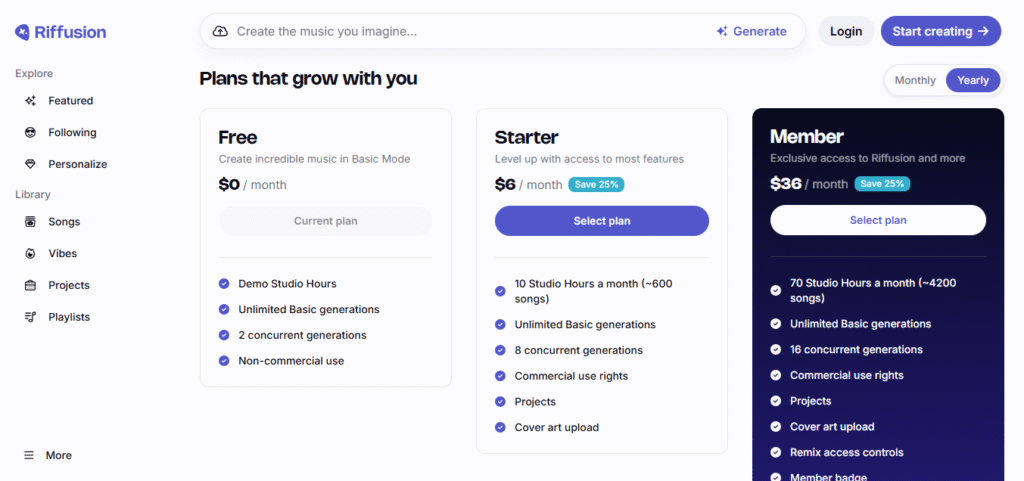
- Free: Complete access to all features
7. Mubert – The Ambient and Electronic Specialist
Best for: Ambient music, electronic genres, streaming content
Mubert focuses on creating endless streams of ambient and electronic music, perfect for background listening and atmospheric content.
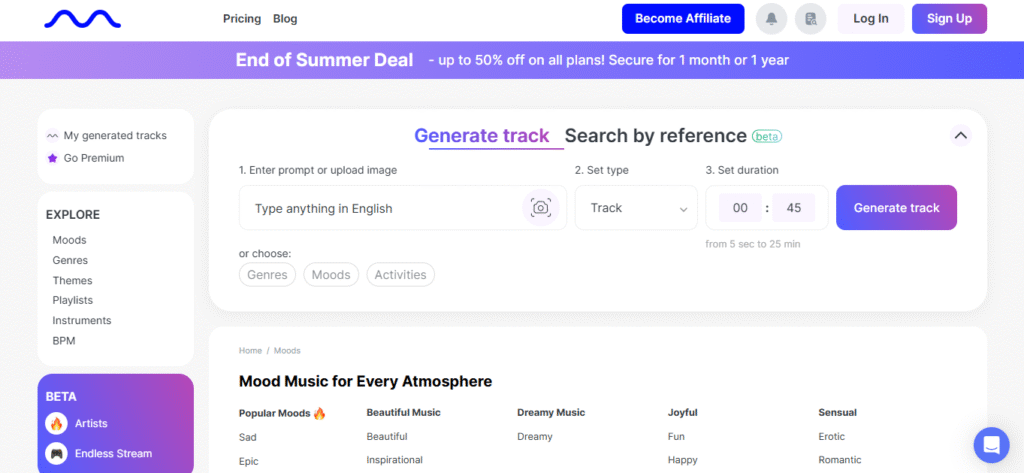
Key Features:
- Infinite Streaming: Generate endless music streams in your preferred style
- Mood-Based Creation: Create music based on activities and emotions
- API Integration: Embed music generation into applications and websites
- Real-Time Adaptation: Music that responds to user activity and preferences
- Multiple Platforms: Mobile apps, web interface, and API access
- Collaborative Features: Work with other creators and musicians
Testing Results:
- Ambient Quality: Excellent for background and atmospheric music
- Electronic Styles: Strong performance in electronic and synthetic genres
- Streaming Experience: Perfect for continuous background music
- API Integration: Good for developers building music applications
Strengths:
- Excellent ambient and electronic music quality
- Infinite streaming capabilities
- Good API for developers
- Real-time adaptive music
- Strong mobile experience
Limitations:
- Limited effectiveness for acoustic genres
- Requires subscription for downloads
- Less suitable for complete song structures
- Primarily background music focused
Pricing:
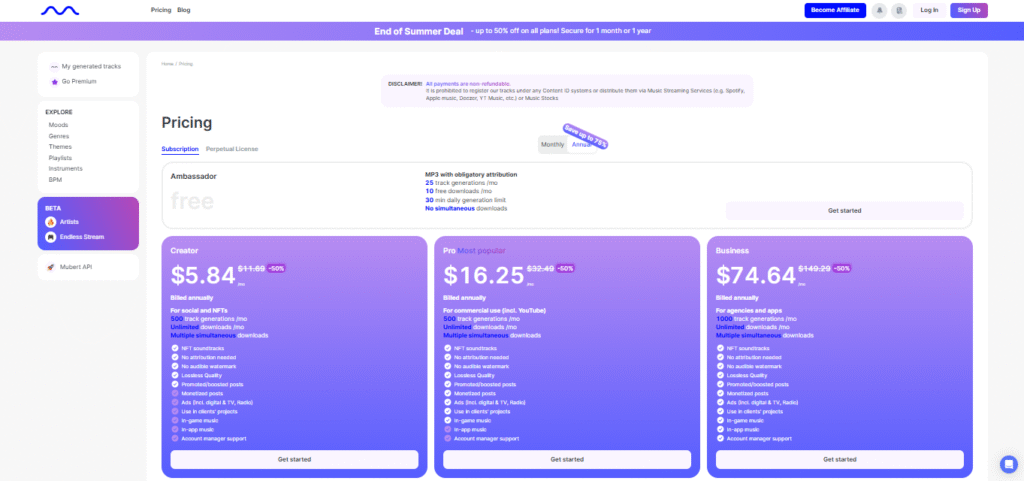
- Free: 25 tracks monthly, Mubert attribution required
- Creator: $14/month (500 tracks, no attribution)
- Pro: $39/month (unlimited tracks, commercial license)
Best Premium AI Music Generators (2025)
1. Amper Music – The Professional Scoring Solution
Best for: Professional media scoring, commercial projects, adaptive music
Amper Music (now part of Shutterstock) provides enterprise-grade AI music generation with advanced customization and professional licensing.
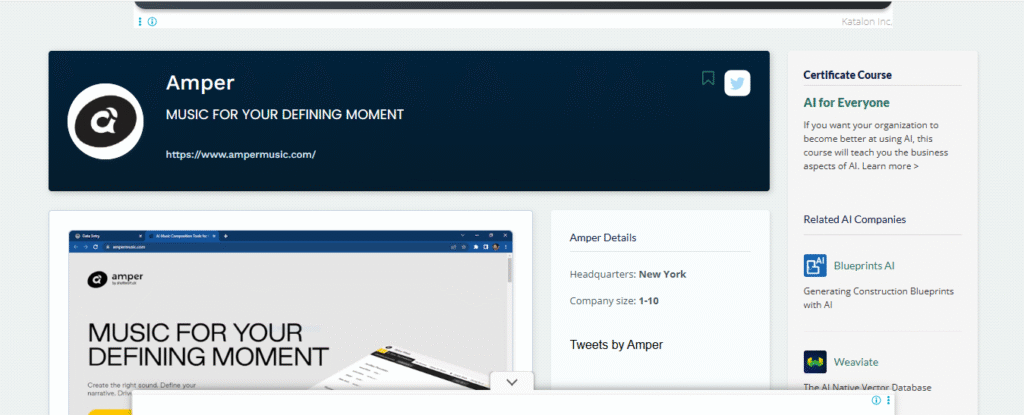
Key Features:
- Adaptive Scoring: Music that adapts to video content and pacing
- Professional Licensing: Clear commercial usage rights and licensing
- Advanced Customization: Detailed control over musical elements and structure
- Industry Integration: Works with major media production workflows
- Quality Assurance: Consistent, professional-grade output quality
- Collaboration Tools: Team features for creative projects
Testing Results:
- Professional Quality: Suitable for broadcast and commercial applications
- Adaptive Features: Excellent synchronization with video content
- Licensing Clarity: Clear, comprehensive commercial usage rights
- Industry Standards: Meets professional media production requirements
Strengths:
- Professional-grade quality and licensing
- Excellent adaptive music capabilities
- Strong industry integration
- Clear commercial usage rights
- Advanced customization options
Limitations:
- Higher cost than consumer tools
- Complex interface requiring training
- Primarily focused on media scoring
- Requires subscription for full features
Pricing:
- Standard: $15/month (professional features)
- Premium: $35/month (advanced collaboration)
- Enterprise: Custom pricing for large organizations
2. LANDR – The Complete Music Production Suite
Best for: Music producers, complete song creation, professional distribution
LANDR combines AI music generation with comprehensive music production tools, offering everything from creation to distribution.
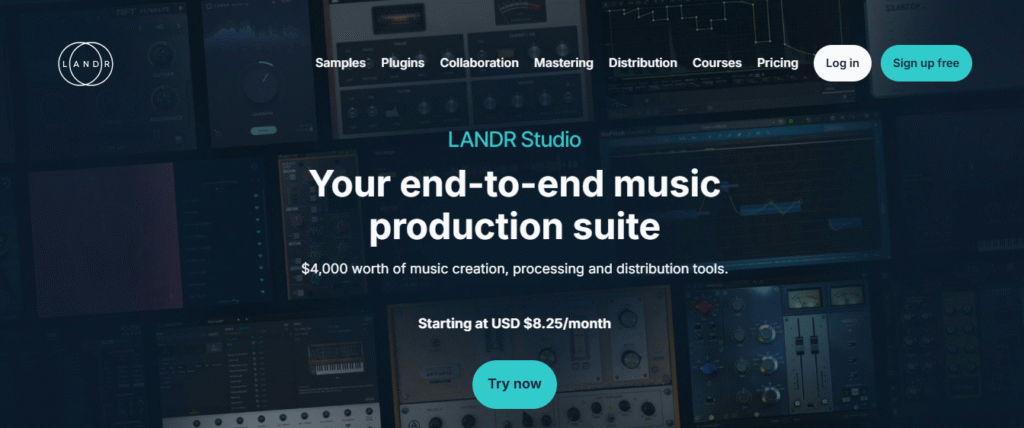
Key Features:
- AI Composition: Generate musical ideas and complete compositions
- Smart Mastering: AI-powered mastering for professional sound quality
- Sample Library: Access to millions of royalty-free samples and loops
- Collaboration Tools: Work with other musicians and producers remotely
- Distribution Network: Release music to streaming platforms worldwide
- Learning Resources: Tutorials and courses for music production
Testing Results:
- Production Quality: Excellent for complete music production workflows
- AI Mastering: Superior automatic mastering compared to manual efforts
- Integration: Seamless workflow from creation to distribution
- Educational Value: Strong learning resources for skill development
Strengths:
- Comprehensive music production ecosystem
- Professional-quality AI mastering
- Global distribution capabilities
- Strong collaboration features
- Educational resources included
Limitations:
- Higher cost for complete feature set
- Learning curve for advanced features
- Subscription required for full access
- May be overwhelming for simple needs
Pricing:
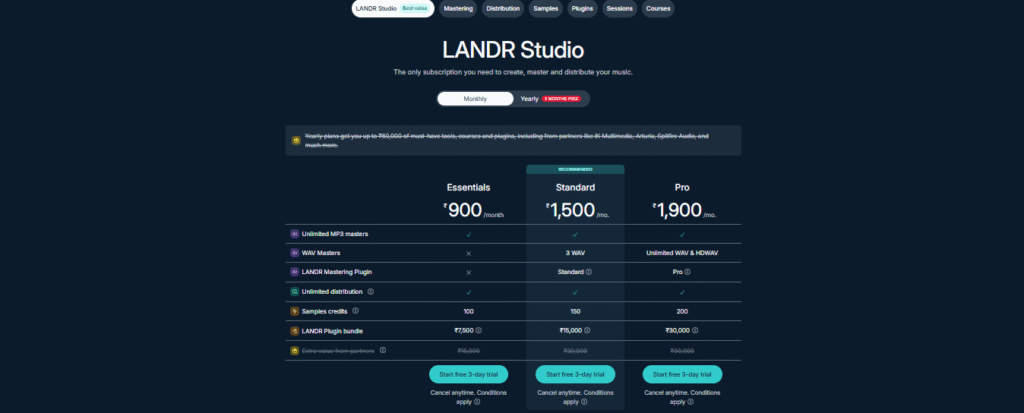
- Creator: $11.99/month (basic features)
- Pro: $19.99/month (advanced tools)
- Studio: $29.99/month (full production suite)
3. Jukedeck – The Enterprise Content Solution
Best for: Large organizations, branded content, enterprise licensing
Jukedeck (acquired by TikTok) focuses on enterprise-grade AI music generation with comprehensive licensing and brand integration.
Key Features:
- Brand Integration: Create music that aligns with brand identity
- Enterprise Licensing: Comprehensive legal protection for commercial use
- Custom Models: Train AI on brand-specific musical preferences
- Volume Processing: Handle large-scale music generation projects
- Quality Consistency: Maintain consistent quality across large projects
- Professional Support: Dedicated support for enterprise customers
Testing Results:
- Enterprise Features: Excellent for large-scale commercial projects
- Brand Alignment: Superior at creating brand-appropriate music
- Legal Clarity: Comprehensive licensing and legal protection
- Volume Capability: Handles large projects efficiently
Strengths:
- Enterprise-grade features and support
- Comprehensive legal protection
- Brand-specific customization
- Scalable for large projects
- Professional customer service
Limitations:
- High cost for individual users
- Complex interface requiring training
- Limited availability (enterprise focus)
- Requires significant commitment
Pricing:
- Enterprise: Custom pricing based on usage and requirements
Specialized AI Music Tools
1. Endel – The Adaptive Wellness Music Creator
Best for: Focus music, relaxation, wellness applications
Endel creates adaptive music that responds to your environment, activities, and biometric data to optimize productivity and wellness.
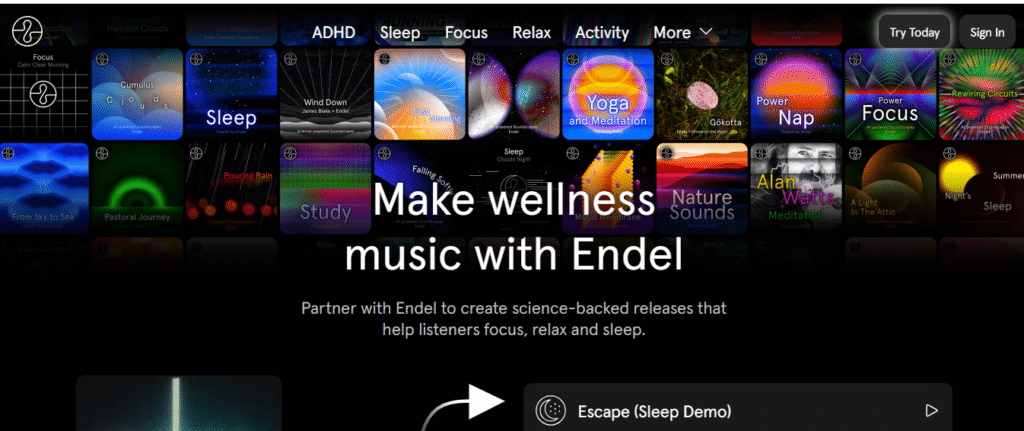
Key Features:
- Adaptive Algorithm: Music that changes based on time, weather, and activity
- Biometric Integration: Responds to heart rate and other health data
- Productivity Focus: Scientifically designed music for concentration and flow states
- Wellness Applications: Sleep, relaxation, and meditation soundscapes
- Personalization: Learns your preferences and optimizes accordingly
- Research-Backed: Based on neuroscience and psychology research
Strengths:
- Unique adaptive music approach
- Scientifically backed for productivity and wellness
- Excellent personalization capabilities
- Multiple application scenarios
- Strong mobile and wearable integration
Limitations:
- Limited traditional music creation features
- Primarily functional rather than entertainment music
- Requires subscription for full personalization
- Not suitable for creative music projects
Pricing:
- Free: Basic adaptive music features
- Premium: $7.99/month (full personalization and features)
2. Brain.fm – The Neuroscience-Based Music Creator
Best for: Productivity enhancement, cognitive performance, scientific applications
Brain.fm uses neuroscience research to create music specifically designed to enhance cognitive performance and mental states.
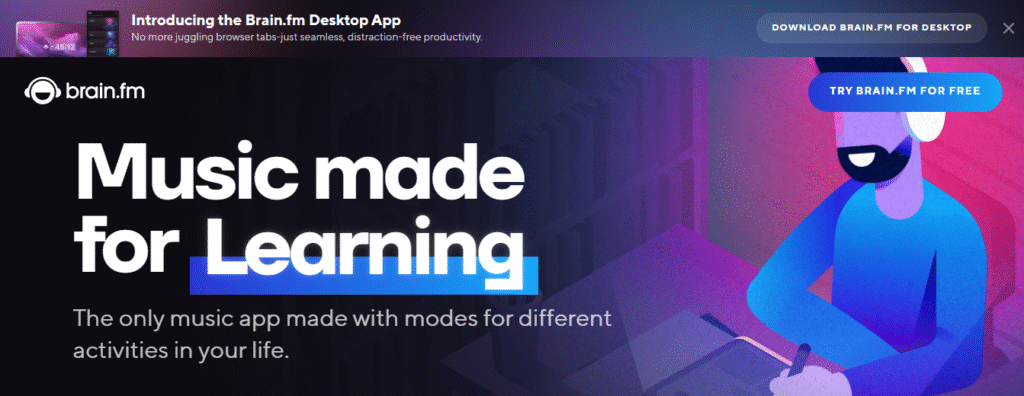
Key Features:
- Neuroscience Foundation: Music designed based on brain research
- Cognitive Enhancement: Tracks specifically for focus, creativity, and relaxation
- Performance Tracking: Monitor productivity improvements while listening
- Scientific Validation: Research-backed effectiveness for cognitive enhancement
- Personalized Algorithms: Adapt to individual brain response patterns
- Professional Applications: Used by productivity experts and cognitive researchers
Strengths:
- Strong scientific foundation and research backing
- Proven effectiveness for cognitive enhancement
- Unique approach to functional music
- Good integration with productivity workflows
- Regular updates based on new research
Limitations:
- Limited entertainment music applications
- Subscription required for full access
- Not suitable for traditional music creation
- Primarily functional rather than creative
Pricing:
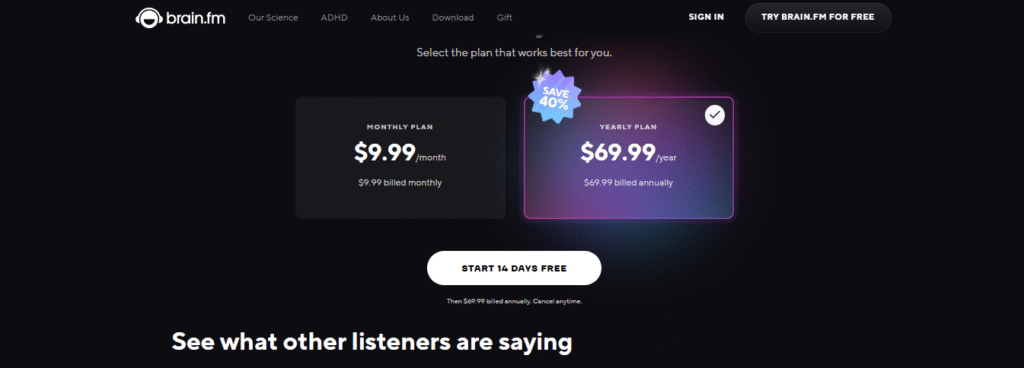
- Free: Limited access to basic tracks
- Premium: $6.99/month (full library and personalization)
3. Amadeus Code – The Melody Generation Expert
Best for: Songwriters, melody creation, musical inspiration
Amadeus Code specializes in generating melodic ideas and chord progressions, serving as an AI co-writer for human musicians
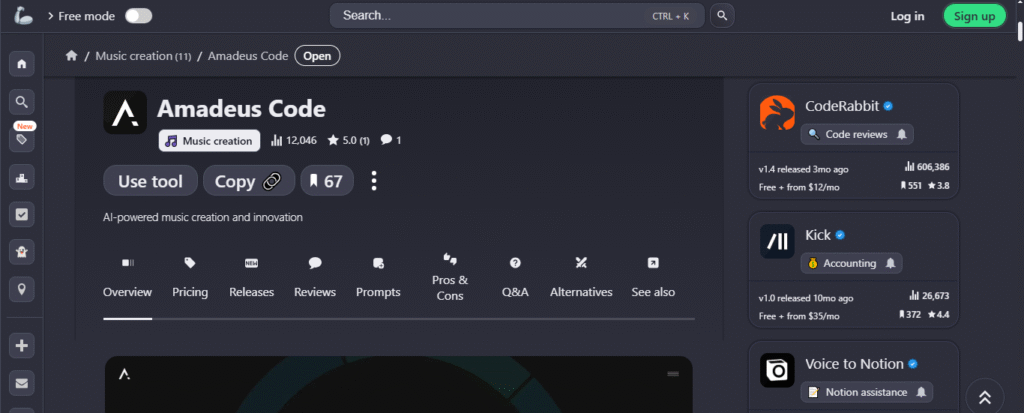
Key Features:
- Melody Generation: Create original melodies and chord progressions
- Song Structure: Generate complete song structures with verses and choruses
- Musical Intelligence: Understands harmony, rhythm, and melodic development
- Inspiration Tool: Provides creative starting points for human composers
- Export Options: MIDI and audio export for further development
- Style Variety: Multiple genres and musical styles available
Strengths:
- Excellent for musical inspiration and idea generation
- Good understanding of musical theory and structure
- Perfect collaboration tool for human musicians
- Multiple export options for different workflows
- Reasonably priced for professional features
Limitations:
- Requires musical knowledge to use effectively
- Limited complete song generation
- Primarily a tool for musicians rather than general users
- Interface complexity for non-musicians
Pricing:
- Free: Limited melody generation
- Premium: $9.99/month (unlimited generation and exports)
Industry-Specific AI Music Applications
Content Creation and Social Media
Use Cases: YouTube videos, TikTok content, Instagram reels, podcast intros
Recommended Tools:
- Soundraw: Perfect background music with easy customization
- Loudly: Optimized for social media content lengths
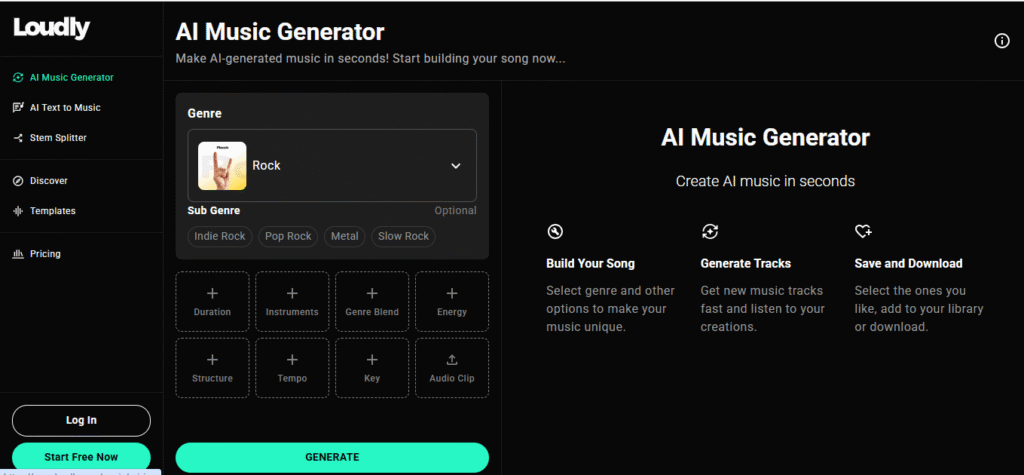
- Epidemic Sound AI: Professional quality with platform-specific optimization
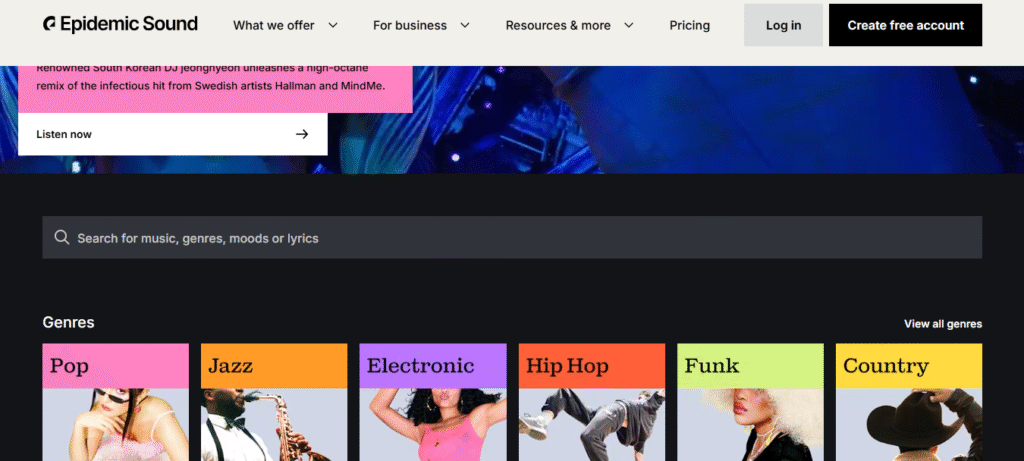
Best Practices:
- Match music energy to content pacing
- Use platform-specific audio formats and lengths
- Ensure music doesn’t overpower spoken content
- Create consistent brand audio identity
Film and Video Production
Use Cases: Movie scoring, documentary soundtracks, commercial music
Recommended Tools:
- AIVA: Professional orchestral and cinematic scoring
- Amper Music: Adaptive scoring that syncs with video
- Jukedeck: Enterprise-grade licensing and quality
Best Practices:
- Sync music timing with visual cuts and pacing
- Use leitmotifs and themes for character and story development
- Balance dialogue, effects, and music levels
- Consider cultural and emotional context
Gaming and Interactive Media
Use Cases: Game soundtracks, interactive experiences, VR applications
Recommended Tools:
- Mubert: Real-time adaptive music for interactive experiences
- LANDR: Complete production suite for game audio
- OpenAI Jukebox: Experimental features for unique gaming experiences
Best Practices:
- Create looping tracks that don’t become repetitive
- Develop music that adapts to player actions and game states
- Ensure music enhances gameplay without distraction
- Optimize file sizes for performance
Business and Corporate Applications
Use Cases: Brand music, corporate videos, presentations, marketing
Recommended Tools:
- Amper Music: Professional licensing and brand-appropriate music
- Beatoven.ai: Business-focused with clear commercial licensing
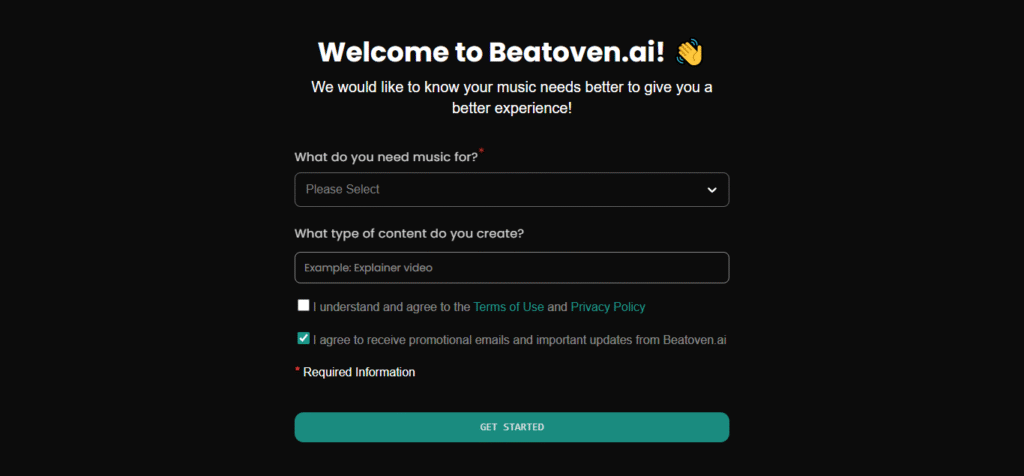
- Jukedeck: Enterprise features and support
Best Practices:
- Align music with brand personality and values
- Ensure legal compliance with comprehensive licensing
- Create music libraries for consistent brand audio identity
- Use music strategically to enhance message impact
Education and Training
Use Cases: Educational videos, training materials, e-learning content
Recommended Tools:
- Brain.fm: Scientifically designed for learning enhancement
- Endel: Adaptive music for concentration and focus
- Soundraw: Customizable background music for educational content
Best Practices:
- Use music that enhances rather than distracts from learning
- Consider cultural sensitivity and accessibility
- Test music effectiveness with target audience
- Maintain consistent audio branding across educational materials
Advanced AI Music Creation Techniques
1. Prompt Engineering for Music
Effective Prompting Strategies:
- Be Specific: Include genre, mood, instruments, and tempo details
- Use Musical Terms: Incorporate proper musical terminology when possible
- Provide Context: Explain the intended use and audience
- Reference Styles: Mention similar artists or songs for style guidance
Example Prompts:
- Instead of: “Happy music”
- Use: “Upbeat pop song in C major, 120 BPM, with acoustic guitar and piano, similar to Ed Sheeran’s style, for a wedding video montage”
2. Layering and Arrangement Techniques
Multi-Tool Workflows:
- Foundation: Use tools like AIVA for harmonic structure
- Melody: Add melodic elements with Amadeus Code
- Production: Enhance with LANDR’s AI mastering
- Effects: Final processing with specialized audio AI tools
3. Style Blending and Innovation
Cross-Genre Experimentation:
- Combine classical structures with electronic elements
- Blend world music influences with contemporary genres
- Mix acoustic and synthetic instruments creatively
- Experiment with unconventional time signatures and rhythms
4. Iterative Refinement Process
Optimization Workflow:
- Generate Multiple Versions: Create several variations of the same concept
- A/B Testing: Test different versions with target audience
- Incremental Improvement: Refine based on feedback and performance
- Quality Assurance: Ensure consistency across final selections
Legal and Ethical Considerations
Copyright and Ownership
AI-Generated Music Rights: Generally, you own music generated by AI tools, but terms vary by platform
Training Data Concerns: Some AI models train on copyrighted music, raising potential legal questions
Commercial Usage: Always verify commercial licensing terms before using AI music professionally
Attribution Requirements: Some platforms require attribution or have specific usage guidelines
Ethical Music Creation
Artist Impact: Consider the impact on human musicians and composers
Cultural Sensitivity: Be respectful when generating music inspired by specific cultures
Quality Standards: Maintain high standards to avoid flooding markets with low-quality content
Transparency: Be honest about AI usage when sharing or selling music
Best Practices for Legal Compliance
Read Terms Carefully: Understand each platform’s specific licensing terms
Document Usage: Keep records of which tools generated which content
Verify Commercial Rights: Ensure you have proper licensing for commercial applications
Respect Attributions: Follow any attribution requirements from AI platforms
Consider Professional Review: For high-stakes projects, consider legal review of usage rights
Building Your AI Music Workflow
Content Creator Workflow
Planning Phase:
- Content Analysis: Understand your content’s emotional arc and pacing
- Musical Requirements: Define genre, mood, length, and energy levels
- Platform Considerations: Account for different platform audio requirements
Creation Phase:
- Tool Selection: Choose appropriate AI music generator for your needs
- Generation: Create multiple musical options and variations
- Customization: Adjust timing, energy, and emotional elements
Integration Phase:
- Audio Editing: Sync music with content using traditional editing tools
- Level Balancing: Ensure music enhances rather than competes with other audio
- Format Optimization: Export in appropriate formats for different platforms
Business and Marketing Workflow
Brand Development:
- Musical Identity: Define your brand’s musical personality and preferences
- Style Guidelines: Create guidelines for consistent musical branding
- Library Building: Generate and organize a library of brand-appropriate music
Campaign Creation:
- Campaign Analysis: Understand target audience and campaign goals
- Musical Strategy: Select music that supports campaign messaging
- Testing and Optimization: A/B test different musical approaches
Implementation:
- Multi-Platform Adaptation: Customize music for different marketing channels
- Performance Tracking: Monitor how music affects campaign performance
- Iterative Improvement: Refine musical choices based on results
Musician and Producer Workflow
Inspiration and Ideation:
- Creative Exploration: Use AI to generate ideas and explore new styles
- Variation Generation: Create multiple versions of musical concepts
- Style Experimentation: Try genres and approaches outside your comfort zone
Production Integration:
- AI as Starting Point: Use AI generations as foundation for human development
- Element Extraction: Extract useful elements (melodies, rhythms, harmonies) from AI output
- Human Enhancement: Add human creativity, emotion, and personal touch
Professional Development:
- Skill Building: Learn new musical styles and techniques through AI exploration
- Productivity Enhancement: Speed up composition and arrangement processes
- Creative Breakthrough: Overcome creative blocks with AI-generated inspiration
The Future of AI Music Generation
The AI music landscape continues evolving rapidly. Here are key trends shaping the future:
Real-Time Interactive Music
Live Performance Integration: AI that responds to live musicians and audiences
Gaming Applications: Music that adapts to player actions and game states
VR and AR Experiences: Immersive music that responds to virtual environments
Social Music Creation: Collaborative platforms for real-time music creation
Enhanced Personalization
Individual Preference Learning: AI that understands and adapts to personal musical tastes
Biometric Integration: Music that responds to physiological and emotional states
Context Awareness: Music that adapts to environment, activity, and social context
Predictive Generation: AI that anticipates musical needs before they’re expressed
Professional Integration
DAW Integration: Native AI features in professional music production software
Live Sound Enhancement: Real-time AI processing for live performances
Collaborative Intelligence: AI as creative partner rather than replacement tool
Educational Applications: AI tutors for music theory and composition learning
Cultural and Accessibility Advances
Global Music Styles: AI trained on diverse cultural musical traditions
Accessibility Features: Tools designed for musicians with disabilities
Language Integration: AI that understands cultural context and linguistic nuances
Democratization: Making professional music creation accessible to everyone
Optimizing Your Website for Music Content
If you’re a musician, content creator, or business using AI-generated music, having a professional website is crucial for showcasing your work and building your brand. Music-focused websites need special considerations for audio playback, portfolio presentation, and user experience.
At Upniche, we understand the unique requirements of music and creative professionals. Our professional website services include optimization for audio content, portfolio showcases, and music player integration. Whether you’re a musician building your brand, a content creator showcasing your work, or a business incorporating music into your marketing strategy, we create websites that properly present and monetize your audio content.
For businesses looking to build affiliate revenue through music-related content, our affiliate marketing websites can help you create platforms that monetize music equipment reviews, software recommendations, and educational content.
Advanced Music Creation Strategies
Multi-Tool Integration Approach
Layer Different AI Outputs: Combine instruments from different AI generators
Human-AI Collaboration: Use AI for foundation, add human creativity for finishing
Style Progression: Start with one AI tool, enhance with others
Quality Enhancement: Use AI mastering tools to polish final outputs
Genre Fusion Techniques
Cultural Blending: Combine musical elements from different cultures respectfully
Temporal Fusion: Blend historical and contemporary musical styles
Instrumental Innovation: Combine traditional and electronic instruments creatively
Rhythmic Experimentation: Merge different rhythmic traditions and patterns
Professional Development Applications
Learning Tool: Use AI to understand different musical styles and techniques
Creative Expansion: Explore genres outside your normal expertise
Productivity Boost: Handle routine composition tasks to focus on creative elements
Quality Reference: Compare your work against AI-generated professional standards
Measuring AI Music Success
Quality Metrics
Audio Fidelity: Technical quality of generated audio
Musical Coherence: Logical musical structure and development
Emotional Impact: Ability to evoke intended emotions and responses
Genre Authenticity: Accuracy in representing chosen musical styles
Practical Metrics
Time Savings: Reduction in music creation and acquisition time
Cost Efficiency: Savings compared to hiring composers or licensing music
Usage Frequency: How often generated music gets used in projects
Audience Response: Engagement and feedback on content featuring AI music
Business Impact Metrics
Content Performance: How AI music affects overall content engagement
Brand Recognition: Musical consistency’s impact on brand awareness
Conversion Rates: Music’s effect on marketing and sales outcomes
Workflow Efficiency: Overall improvement in creative and business processes
Troubleshooting Common AI Music Issues
Poor Quality Output
Symptoms: Distorted audio, unnatural transitions, repetitive patterns
Solutions:
- Try different AI models or tools
- Refine prompts with more specific musical terms
- Use post-processing tools to enhance quality
- Combine multiple AI outputs for better results
Licensing and Usage Concerns
Symptoms: Uncertainty about commercial usage rights
Solutions:
- Carefully read platform terms of service
- Choose tools with clear commercial licensing
- Document your usage and generation sources
- Consider legal consultation for high-stakes projects
Limited Customization
Symptoms: Generated music doesn’t match specific requirements
Solutions:
- Use multiple tools for different elements
- Employ traditional editing software for final adjustments
- Learn prompt engineering techniques for better control
- Consider premium tools with advanced customization
Integration Challenges
Symptoms: Difficulty incorporating AI music into existing workflows
Solutions:
- Choose tools with appropriate export formats
- Use audio editing software as intermediary step
- Develop standardized processes for AI music integration
- Train team members on AI music tool usage
Conclusion: Your Musical Future Starts Now
The AI music revolution is transforming how we create, consume, and think about music. Whether you’re a content creator needing background tracks, a business building brand identity, or a musician seeking creative inspiration, AI music generators offer unprecedented opportunities to enhance your creative capabilities.
For beginners and casual users, I recommend starting with Suno AI for complete songs or Soundraw for background music. These tools offer excellent free tiers and user-friendly interfaces that require no musical knowledge.
For content creators and businesses, consider investing in tools like Amper Music or LANDR that provide professional quality with clear commercial licensing.
For musicians and producers, use AI as a creative partner—tools like Amadeus Code for inspiration, AIVA for orchestral arrangements, or open-source options like MusicGen for experimental exploration.
For specialized applications, explore tools like Endel for productivity music or Brain.fm for neuroscience-based audio enhancement.
Remember, AI music generation works best when it complements human creativity rather than replacing it. The most successful creators in 2025 will be those who learn to collaborate effectively with AI, using these tools to handle routine tasks while focusing their human creativity on emotional expression, cultural relevance, and authentic artistic vision.
The democratization of music creation is here. Professional-quality music is no longer limited to those with years of training or expensive equipment. Start experimenting with these tools today, and discover how AI can amplify your creative potential and transform your projects.
Your musical journey into the AI age begins now. Which tool will you use to create your first AI-generated masterpiece?
Essential AI Music Creation Checklist
Before using AI-generated music in your projects, ensure you’ve covered these critical aspects:
Legal and Licensing
- [ ] Commercial Rights: Verify you have proper commercial usage rights
- [ ] Attribution Requirements: Check if tool requires attribution or credit
- [ ] Platform Compliance: Ensure music meets platform-specific licensing requirements
- [ ] Documentation: Keep records of which tools generated which content
- [ ] Terms of Service: Read and understand each platform’s specific terms
Quality Assurance
- [ ] Audio Quality: Check for distortion, artifacts, or technical issues
- [ ] Musical Coherence: Ensure music has logical structure and development
- [ ] Emotional Alignment: Verify music supports intended mood and message
- [ ] Length Appropriateness: Confirm duration matches content requirements
- [ ] Format Compatibility: Export in appropriate formats for intended use
Integration and Workflow
- [ ] Content Synchronization: Ensure music timing aligns with visual content
- [ ] Audio Levels: Balance music with other audio elements appropriately
- [ ] Platform Optimization: Optimize for target platform’s audio requirements
- [ ] Backup Options: Have alternative music choices ready if needed
- [ ] Version Control: Maintain organized files and project versions
Strategic Considerations
- [ ] Brand Alignment: Ensure music matches brand personality and values
- [ ] Audience Appropriateness: Consider target audience preferences and cultural sensitivity
- [ ] Competitive Differentiation: Use music to distinguish from competitors
- [ ] Scalability: Choose sustainable approaches for ongoing music needs
- [ ] Performance Tracking: Plan how to measure music’s impact on content performance

